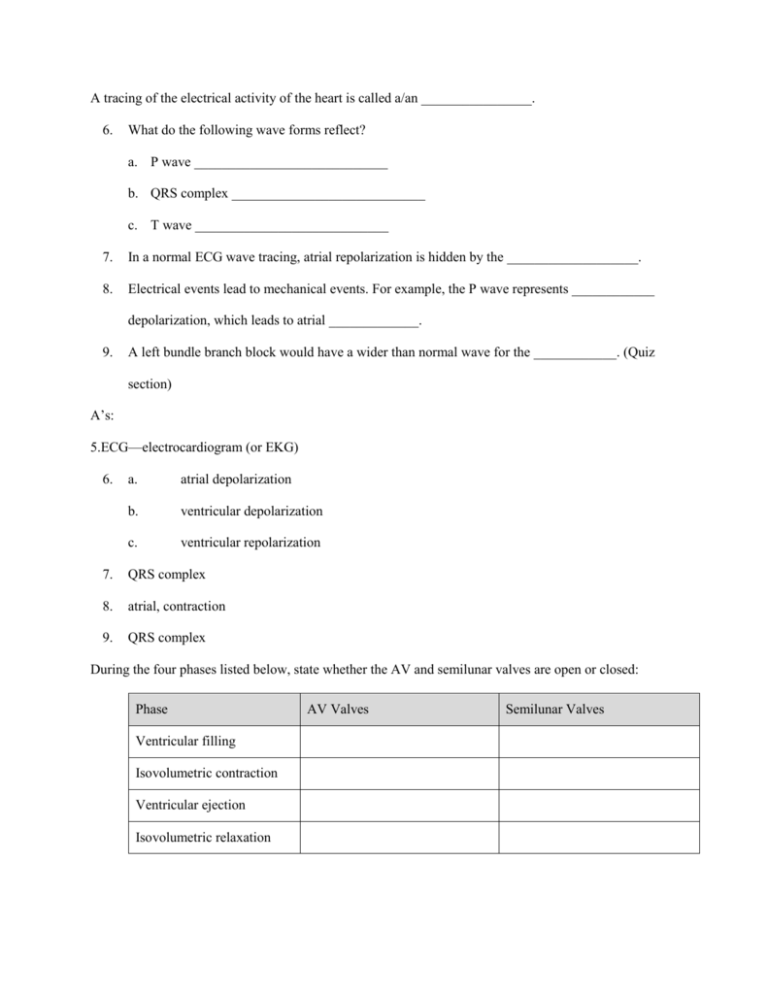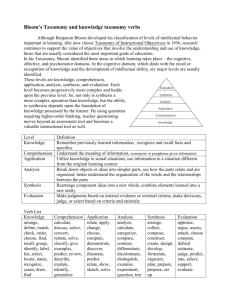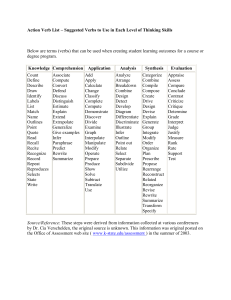A tracing of the electrical activity of the heart is called a/an . 6. What
advertisement

A tracing of the electrical activity of the heart is called a/an ________________. 6. What do the following wave forms reflect? a. P wave ____________________________ b. QRS complex ____________________________ c. T wave ____________________________ 7. In a normal ECG wave tracing, atrial repolarization is hidden by the ___________________. 8. Electrical events lead to mechanical events. For example, the P wave represents ____________ depolarization, which leads to atrial _____________. 9. A left bundle branch block would have a wider than normal wave for the ____________. (Quiz section) A’s: 5.ECG—electrocardiogram (or EKG) 6. a. atrial depolarization b. ventricular depolarization c. ventricular repolarization 7. QRS complex 8. atrial, contraction 9. QRS complex During the four phases listed below, state whether the AV and semilunar valves are open or closed: Phase Ventricular filling Isovolumetric contraction Ventricular ejection Isovolumetric relaxation AV Valves Semilunar Valves Chamber Valve Chamber/Vessel Right ventricle Pulmonary semilunar Pulmonary trunk Left ventricle Aortic semilunar Semilunar aorta Left atrium Mitral Left ventricle Right atrium Tricuspid Right ventricle a.Ventricular filling occurs during ______________ ventricular ____________. b. Blood flows through the __________, or __________, valves into the ventricles. a.mid to late, diastole b. atrioventricular, AV The first heart sound ("lub") A) is associated with atrial systole. B) is associated with closing of the mitral valve. C) is associated with opening of the mitral valve. D) is associated with closing of the aortic valve. E) is associated with opening of the aortic valve. Answer: B Learning Outcome: 20-3 Bloom's Taxonomy: Knowledge The phase in the cardiac cycle when the mitral valve is closed and the aortic valve is open is the A) atrial systole. B) early diastolic filling phase. C) late diastolic filling phase. D) systolic ejection phase. E) dicrotic phase. Answer: D Learning Outcome: 20-3 Bloom's Taxonomy: Comprehension End-systolic volume is defined as the: A) amount of blood a ventricle ejects per cycle B) amount of blood which backflows into a ventricle C) amount of blood remaining in an atrium after atrial systole D) amount of blood remaining in a ventricle after contraction E) stroke volume multiplied by the heart rate Answer: D Learning Outcome: 20-4 Bloom's Taxonomy: Comprehension Considering the left ventricle, why does isovolumetric ventricular contraction occur during ventricular systole? A) The ventricle needs to pressurize the blood to close the aortic valve. B) Ventricular pressure is greater than atrial pressure so the ventricle cannot eject blood. C) The bicuspid valve needs time to shut before the ventricle can eject blood. D) Aortic pressure is higher than ventricular pressure and the ventricle must pressurize the blood to open the aortic valve. E) The ventricle is still filling with blood and therefore cannot eject blood during this time. Answer: D Learning Outcome: 20-3 Bloom's Taxonomy: Comprehension During ventricular systole, the A) atria are contracting. B) blood is entering the ventricles. C) AV valves are closed. D) pressure in the ventricles remains constant. E) pressure in the aorta remains constant. Answer: C Learning Outcome: 20-3 Bloom's Taxonomy: Comprehension Figure 20-2 Cardiac Cycle Use Figure 20-2 to answer the following questions: 90) What occurs at the area labeled "D" on the graph? A) AV valve opens B) semilunar valve opens C) diastolic filling begins D) AV valve opens and diastolic filling begins E) ventricle contracts Answer: D Learning Outcome: 20-3 Bloom's Taxonomy: Comprehension 91) What volume is labeled "G" on the graph? A) cardiac output B) stroke volume C) end-systolic volume D) end-diastolic volume E) ejection fraction Answer: C Learning Outcome: 20-3 Bloom's Taxonomy: Comprehension 92) What occurs at "A" on the graph? A) semilunar valve opens B) semilunar valve closes C) AV valve opens D) AV valve closes E) end systolic volume Answer: A Learning Outcome: 20-3 Bloom's Taxonomy: Comprehension 93) What volume is labeled "E" on the graph? A) cardiac output B) stroke volume C) end-diastolic volume D) end-systolic volume E) total cardiac volume Answer: B Learning Outcome: 20-3 Bloom's Taxonomy: Comprehension 94) What occurs at the circled label "5" on the graph? A) peak systolic pressure B) isovolumetric systole C) isovolumetric contraction D) ventricular refilling E) increased heart rate Answer: A Learning Outcome: 20-3 Bloom's Taxonomy: Comprehension 95) What occurs at the area labeled "B" on the graph? A) ventricular ejection occurs B) AV valve closes C) semilunar valve opens D) semilunar valve closes E) AV valve opens Answer: D Learning Outcome: 20-3 Bloom's Taxonomy: Comprehension 96) What occurs at the circled label "4" on the graph? A) ventricular ejection B) sympathetic stimulation C) isovolumetric ventricular contraction D) isovolumetric ventricular relaxation E) ventricular filling Answer: C Learning Outcome: 20-3 Bloom's Taxonomy: Comprehension 97) What occurs at the circled label "7" on the graph? A) isovolumetric ventricular relaxation B) sympathetic stimulation C) isovolumetric ventricular contraction D) ventricular ejection E) ventricular filling Answer: A Learning Outcome: 20-3 Bloom's Taxonomy: Comprehension 98) What volume is labeled "F" on the graph? A) cardiac output B) end-systolic volume C) end-diastolic volume D) total cardiac volume E) stroke volume Answer: C Learning Outcome: 20-3 Bloom's Taxonomy: Comprehension 99) What occurs at the area labeled "C" on the graph? A) AV valve opens B) AV valve closes C) ventricular filling begins D) semilunar valve closes E) semilunar valve opens Answer: B Learning Outcome: 20-3 Bloom's Taxonomy: Comprehension 100) What is occurring in the left atrium at the circle labeled "2" on the graph? A) left atrium is pressurizing the left ventricle B) left atrium is in systole C) left atrial pressure is decreasing D) left atrium is in diastole E) left atrium is receiving pressure from the left ventricle Answer: B Learning Outcome: 20-3 Bloom's Taxonomy: Comprehension 101) With each ventricular systole, A) blood pressure remains steady. B) the ventricles fill with blood. C) blood pressure decreases. D) cardiac output decreases. E) blood pressure increases. Answer: E Learning Outcome: 20-3 Bloom's Taxonomy: Comprehension The volume of blood ejected from each ventricle during a contraction is called the A) end-diastolic volume. B) end-systolic volume. C) stroke volume. D) cardiac output. E) cardiac reserve. Answer: C Learning Outcome: 20-4 Bloom's Taxonomy: Knowledge A patient's ECG recording shows a very long P-R interval. What is the cause of this abnormal wave pattern? Answer: The P wave marks the time of atrial depolarization and the QRS complex signals ventricular depolarization. Between those two events the AV node was excited and the action potential was spread through the conducting tissue to the ventricular myocardium. A prolonged P-R interval signifies an usually slow conduction through the AV node and conducting system, possibly due to insufficient blood flow (ischemia). Learning Outcome: 20-2 Bloom's Taxonomy: Application Abnormally slow depolarization of the ventricles would most change the shape of the ________ in an ECG tracing. A) P wave B) T wave C) QRS complex D) P-R interval E) R-T interval Answer: C Learning Outcome: 20-2 Bloom's Taxonomy: Comprehension The P wave of the electrocardiogram is a signal from A) depolarization of the SA node. B) depolarization of the AV node. C) depolarization of the atria. D) repolarization of the atria. E) depolarization of the ventricles. Answer: C Learning Outcome: 20-2 Bloom's Taxonomy: Knowledge Depolarization of the atria corresponds to the EKG's A) P wave. B) QRS complex. C) QT interval. D) T wave. E) S-T segment. Answer: A Learning Outcome: 20-2 Bloom's Taxonomy: Comprehension If there is a complete block between the SA node and the AV node, how would the ECG be affected? A) The P-R interval will be shorter. B) The QRS duration will be longer. C) There will be much bigger P waves. D) The ventricles will stop beating. E) The rate of P waves will be faster than the rate of QRS complexes. Answer: E Learning Outcome: 20-2 Bloom's Taxonomy: Application Depolarization of the ventricles is represented on an electrocardiogram by the A) P wave. B) T wave. C) S wave. D) QRS complex. E) PR complex. Answer: D Learning Outcome: 20-2 Bloom's Taxonomy: Knowledge Abnormally slow depolarization of the ventricles would most change the shape of the ________ in an ECG tracing. A) P wave B) T wave C) QRS complex D) P-R interval E) R-T interval Answer: C Learning Outcome: 20-2 Bloom's Taxonomy: Comprehension The T wave on an ECG tracing represents A) atrial depolarization. B) atrial repolarization. C) ventricular depolarization. D) ventricular repolarization. E) ventricular contraction. Answer: D Learning Outcome: 20-2 Bloom's Taxonomy: Knowledge During the T wave of the electrocardiogram, the ventricles are A) depolarizing. B) repolarizing. C) contracting. D) relaxing. E) both repolarizing and relaxing. Answer: E Learning Outcome: 20-2 Bloom's Taxonomy: Comprehension ) Analysis of the electrocardiogram can reveal all of the following, except the A) heart rate. B) stroke volume. C) condition of the conducting system. D) effects of drugs and poisons. E) duration of the ventricular action potential. Answer: B Learning Outcome: 20-2 Bloom's Taxonomy: Knowledge The Q-T interval indicates the time required for the ventricles to undergo a single cycle of ______________________ and __________________. depolarization repolarization 99) What occurs at the area labeled "C" on the graph? A) AV valve opens B) AV valve closes C) ventricular filling begins D) semilunar valve closes E) semilunar valve opens Answer: B Learning Outcome: 20-3 Bloom's Taxonomy: Comprehension 100) What is occurring in the left atrium at the circle labeled "2" on the graph? A) left atrium is pressurizing the left ventricle B) left atrium is in systole C) left atrial pressure is decreasing D) left atrium is in diastole E) left atrium is receiving pressure from the left ventricle Answer: B Learning Outcome: 20-3 Bloom's Taxonomy: Comprehension









